Reviewing the Appletree Appleslice V3 and Skipper Prone DW Wing and Surf Foil Boards
In this edition of Wing Wednesdays, Tucker and Jeff are taking a look at a couple of Appletree boards, the Appleslice V3 and the Skipper Prone. What did they think of these boards when they rode them, and where do they fit in their quivers? Which one might be right for you?
Appleslice V3
The Appleslice has been the go-to board in the Appletree lineup. The construction and thoughtful design have made them a shop favorite. The sizing is always on point, and the quality makes them a standout.
Appletree tends to do things a bit differently from other brands, so you can usually expect something cool and fresh from their gear, and the 2024 Appleslice is no exception. They've modernized the dimensions and shape, and if you choose the right size, you could even try a one-board quiver.
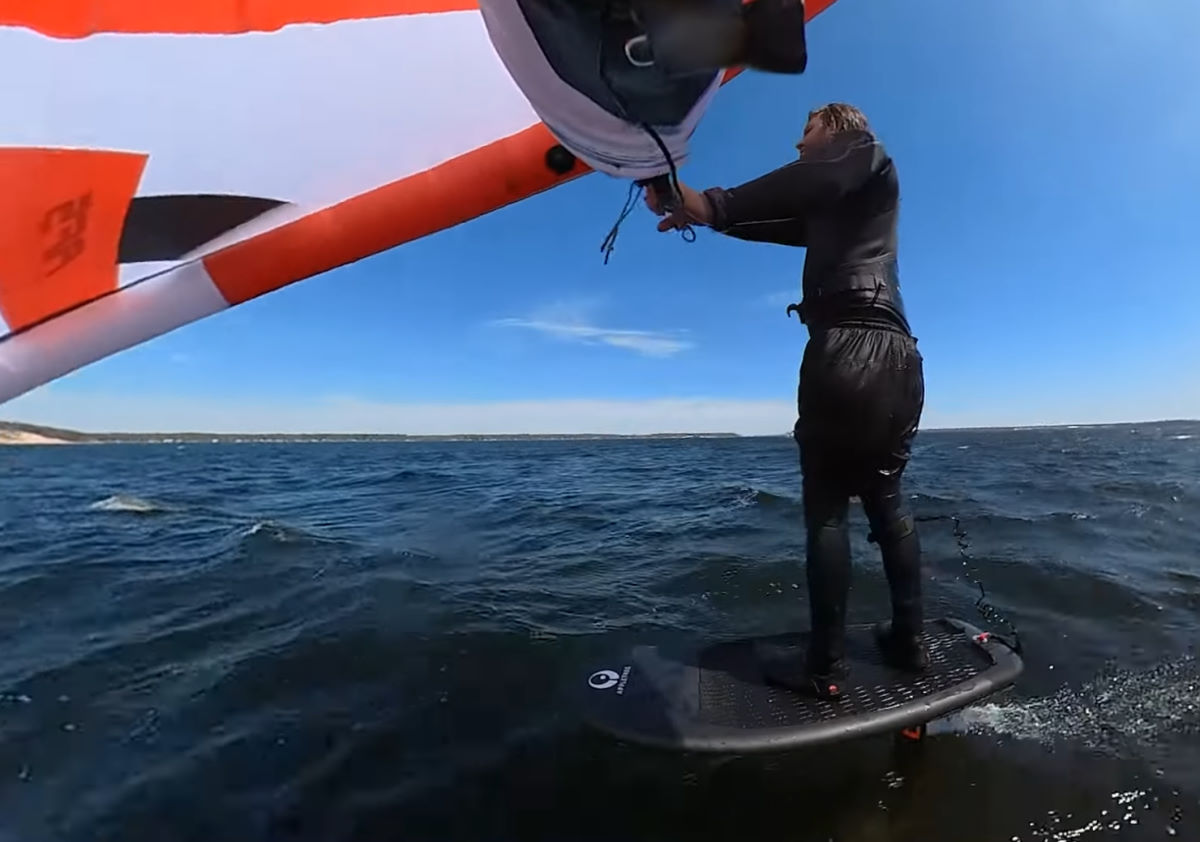
Riding Characteristics
Tucker is 200lbs and Jeff is 175, and they've been testing the 60L board. While this would not be a one-board quiver for them in Michigan with the tendency towards lighter winds, it does have the benefit of front-to-back stability due to its relatively long, narrow dimensions. It's not a downwind board, but it's a great size for a higher wind board. It's 5'0" x 21.6" x 3", so it's a bit longer and narrower than previous 60L models. That hybrid approach to sizing has been a welcome trend in the industry.
A lot of the ease-of-use of a board comes from its length and the resulting stability. The sweet spot on a board gets larger as the board gets longer. Side-to-side stability comes from the foil and increases as you gain speed, plus your body is built to adapt to side-to-side motion more than front-to-back, so the board doesn't need to be as wide. When you're kneeling, it's a lot easier to balance side-to-side as well. Since most people (though not Jeff) start knees forward, the extra front-to-back stability is a welcome upgrade.
A longer, narrower board is going to get up to speed more easily as well. You'll generally be riding a mid-higher aspect foil with this board and, because of that, when you're in wavy, undulating conditions on the surface, it won't want to submarine and will help to keep the board flat so you can get up on those foils. It's also sleeker and cuts through the water better since you're not pushing aside as much water as you would with a short, fat board. If you're on a smaller, higher aspect foil, you might not be able to reach enough speed to get up on a board that's too wide.
On the bottom of the board, looking forward from about halfway to the nose, you'll see that it has quite a low entry rocker, and the center portion of the nose is even a bit higher than the rocker line, with a sort of hole on the sides. This keeps the hull in contact with the water and guides the flow so you're not slapping as you accelerate. As you begin to lift off, only the center of the board will still be touching the water, resulting in a very fast profile. The chines run almost straight back, so the outline won't add any drag. The tail rocker is very flat for a clean release off the tail.

This board will accelerate and release off the water very cleanly and quickly. True to its name, it slices through the water.
Board Characteristics
The biggest change for this year is the dimensions, with it being a little longer and narrower. It's a bit surfier shape, and the holes on the sides of the nose really do give it a smoother ride. When you touch down at speed, this allows it to keep going without feeling like the brakes have been put on. It disperses the water very well and gives you the opportunity to get back up to speed and take off again.
If you want to have a one-board quiver, you'll need to look at your weight and the wind conditions where you ride. In a windy place like Maui or Hood River, a 60L would work in the 175lb range, though at 200lb it's s sinker and needs to get moving to gain that stability and lift. In Michigan, you should consider sizing up since there tend to be many more light wind days.
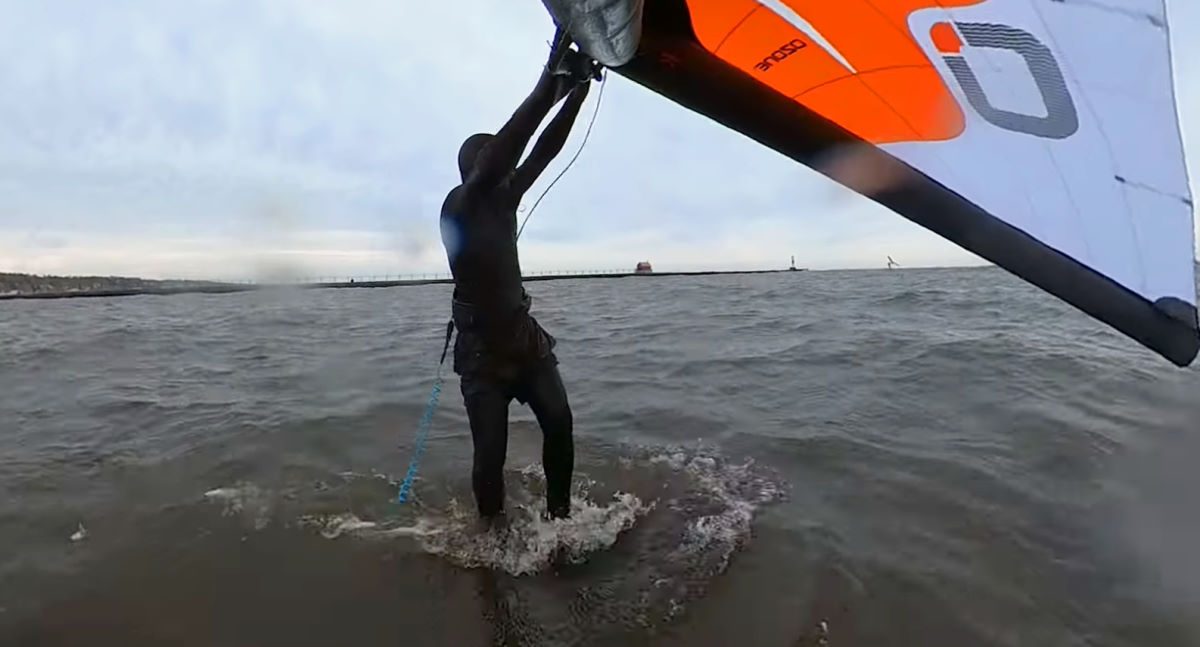
The deck is concave but very flat through most of the standing area, so it's intuitive and you'll feel locked in and comfortable without having it be too responsive. It does ramp up a bit toward the edge so you can get some leverage into the foil, especially on wider foils. It also gives you a sense of where your feet are without having to look down.
A couple years ago, Appletree changed their padding to have a bit more grip, and this one has a good balance of just enough grip without being overly grippy. It's got a nice diamond texture. In the past they just used a corduroy texture with a thinner pad, so you'd want to use wax with it. You won't need to wax this one.
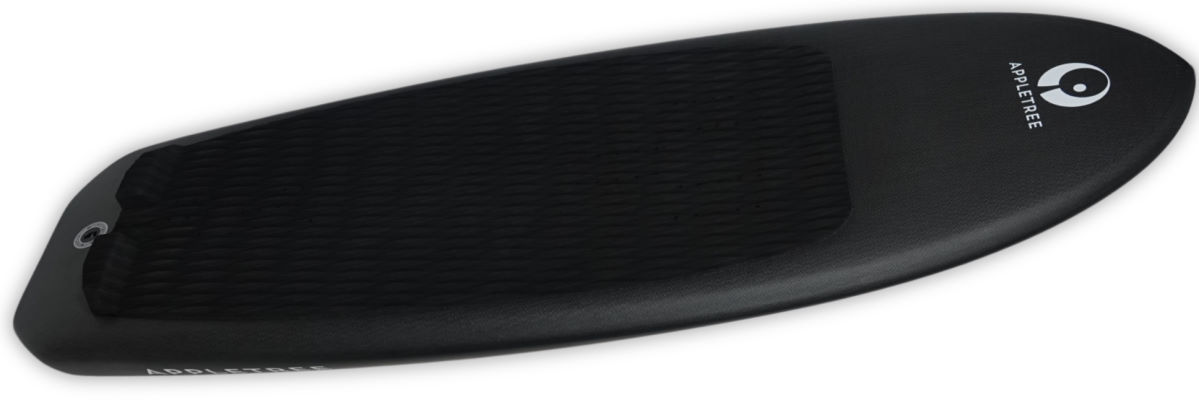
The nose has a bit of a bulb to help keep it high when you're knee starting. This can be a big help when you've got waves crashing over you. The nose will resurface first to keep it from pearling down.
You've got a number of good strap layout options on this board. You can set it up with a single directional strap, or use two straps for a V setup. There isn't a centered hole for a dedicated V strap, though. The back has a less common but useful offset option for when you're riding directional. The board also works great strapless, which is nice for newer riders since straps can get in the way and even hold you back when you haven't progressed to a style that needs them.
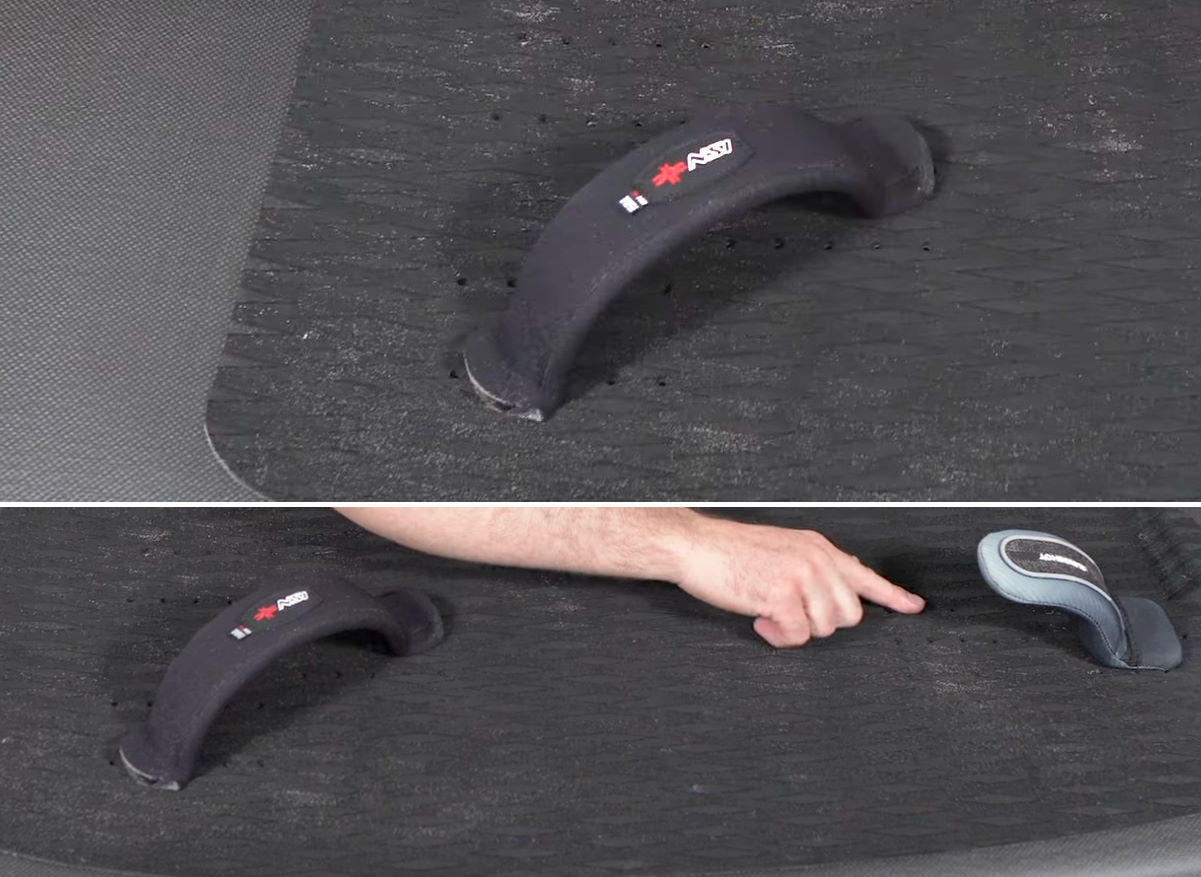
Who Is It For?
Although the Appleslice was designed as a surf and freeride board, it also jumps well. If you enjoy freestyle as well as surf and freeride, this board would be a solid choice. Its hybrid approach makes it viable as a one-board quiver. You can charge on waves and wing in a variety of wind ranges.
If you're an intermediate rider, you can size up a little to have something that will work well for everything. If you're an advanced rider, you can size down. You'll lose a bit of low end, but you probably have a low wind board for those days anyway, if you ride those days at all.
Jeff's Pick
Jeff is about 175lbs and would choose the 70L Appleslice, hands-down. Due to its length, he could push it to the lower end of the wind range.
Tucker's Pick
Tucker loves the 60L, but he loses enough low end that his one-board quiver choice is the 70L, or even the 80L if he rode mainly in warmer weather when the wind tends to be lighter. He feels that a little extra volume won't hurt, especially since the narrow design of the board will still let you rip around. It feels smaller than it is once you're up on foil, and the weight is distributed very well.
Appleslice vs. Omen Flux
A lot of people who are looking at the Appleslice 60L may also be looking at the Omen Flux 60L. They're made in the same factory, use the same construction, and are aimed at a similar audience, but have different shapes. How do they compare?
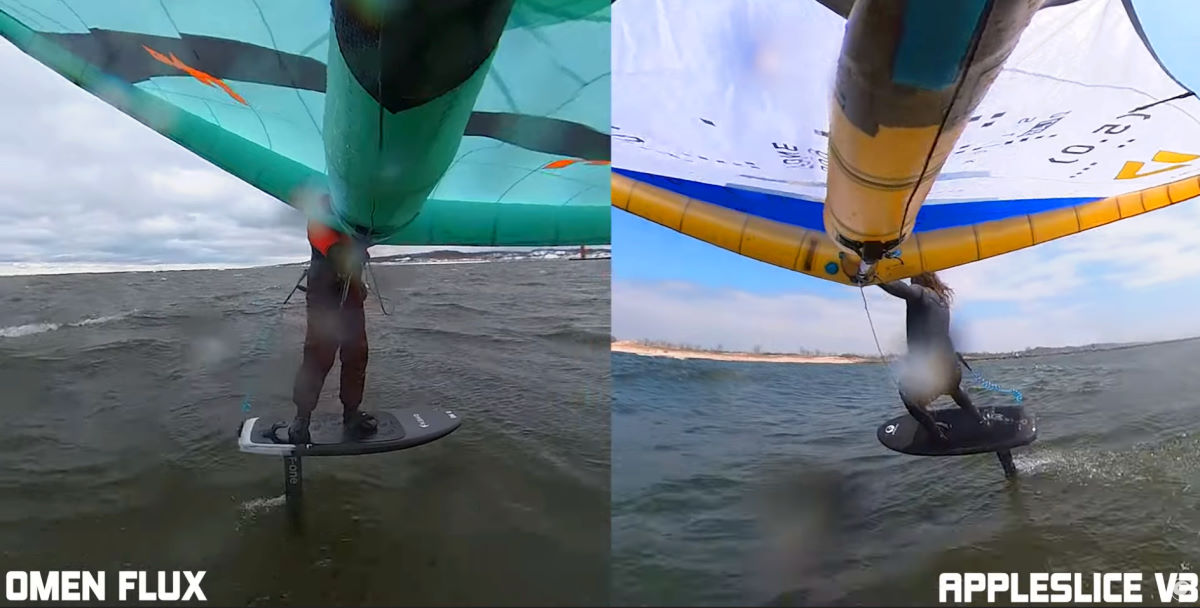
Jeff feels the main difference it that the Appleslice has a bit more all-around stability. Tucker felt like he wanted to size up on the Appleslice. It's a little shorter and wider than the Flux, yet feels narrower regarding plane-ability since the surface area on the bottom of the board is narrower.
For those reasons, Tucker thinks the 70 Appleslice is more comparable to the 60 Flux. While he can get the Appleslice 60 going in the same light wind as the Flux 60, it does take more effort.
Both are excellent boards with durable construction. They use closed-cell foam, so if you do get a ding in your board, you can keep riding without having to worry about it soaking up water. This is especially handy if you're on a trip and might not have easy access to resin or a repair shop, and let's face it- trips can be tough on our gear. EPS is a great, lightweight core that most brands are using, but it does degrade over time, particularly if it gets wet. The Appleslice and Flux use a poly material that can last a very long time.
The factory is in Portugal, with headquarters in the Netherlands, so these are boards designed and built by riders for riders. By owning their factory, they have full control over the materials and assembly, and it shows in the fit and finish of their gear. You can even get custom colors if that's your thing, and MACkite can help you get set up with that.
Skipper Prone Downwind
Riding Characteristics
As the name implies, the Appletree Skipper Prone Downwind lets you paddle into waves sooner, easier, and with more speed, with the idea that you're going to downwind it. While this does take a bit of skill, if you're a surfer who's new to prone, you'll love the Skipper. It paddles fast and it's got a lot of length and stability, which gives you a lot of forgiveness while trying to learn prone foiling.
If you're into more than just prone, the skipper has you covered as well. It's a bit of a jack-of-all-trades since you can use it for winging, Foil Drive, crossover, and even wake.

The dimensions of the board we tested are 5'9" x 18" x 4.1" and 57 L, so it's fairly low volume for riders in the 175-200lb range who want to wing. However, the efficiency of the length and the shape make up for that. It's not a light wind option; if it had 20 or 30L more, then it'd be phenomenal for that, but it does have the efficiency and speed to get even small foils going.
Normally, you need a lot of wind and lift to get a small, racy foil up. You can't reach lifting speed while most boards are on the water, so you need to skip them to accelerate off the water and take off, which requires a lot of lift and power from the wing. However, this board's shape cuts through the water like a downwind board with very little drag, and that allows you to reach lifting speed while still on the water.
The board also comes in smaller sizes, so it's really prone-focused, but intermediate wingers and above can certainly use the 57L, especially with a Foil Drive.
Board Characteristics
The deck is flat, and there are no inserts for straps. It is a super light board that's designed to be quick. It's not made for jumping; it's just a useful, clean shape.

It could become very popular with Foil Drivers. It's got the length that's important with Foil Drive so that the nose can plane up to get the board moving on the water and let you get to your feet and lift off on the foil. Too short a board, and you'll either ride a wheelie or pearl the nose. You won't be able to get up to speed, especially if you're bouncing off chop. The longer, narrower shape ramps up the efficiency and makes it easier to take off on smaller foils.
Appleslice vs. Skipper
For almost everyone, the easy choice is the Appleslice. It's versatile and comes in a nice range of sizes. However, if you're into Foil Drive or riding smaller, faster foils in conditions where it can be hard to get going, the Skipper has some unique benefits. The Skipper is also a good choice if you enjoy prone foiling and want a crossover into your wing board.
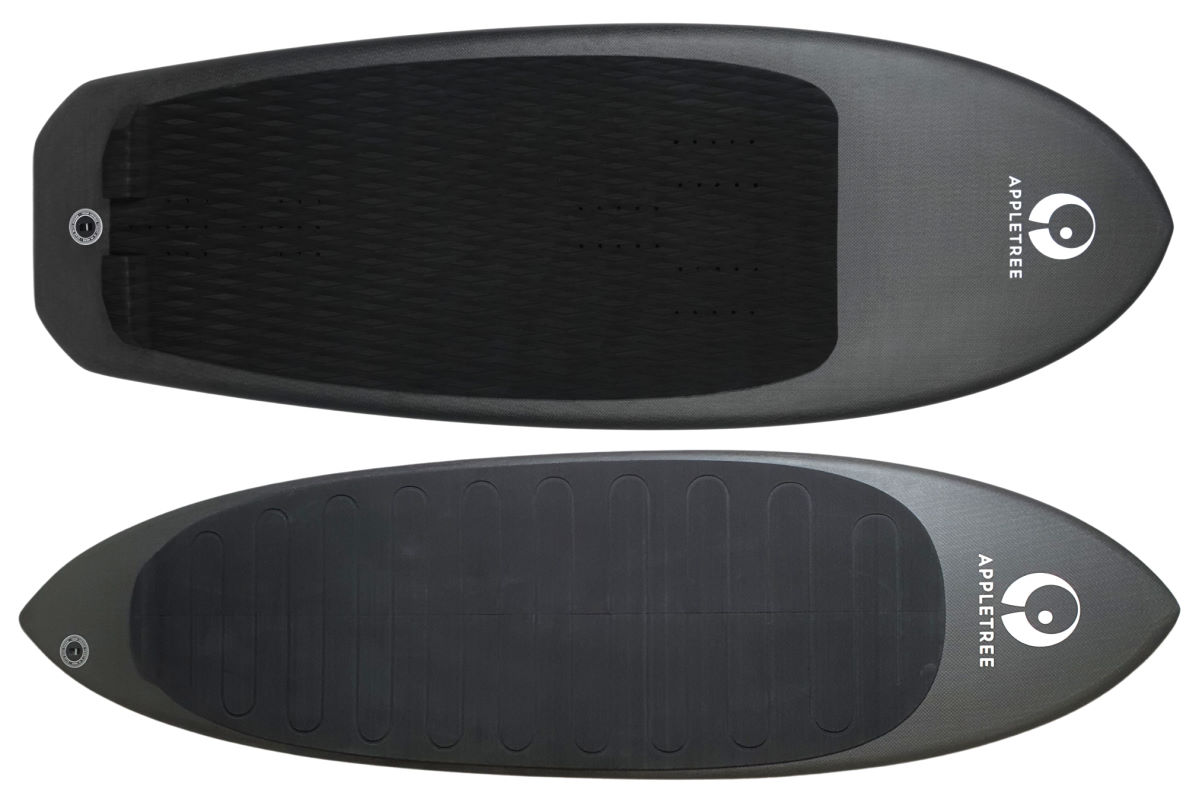
With the 57L being the largest size in the Skipper, it is a bit of a niche board. It's too small for SUP foiling. However, if you need something larger, you can always transition to the Downwind Skipper, which is also a great light wind board for winging.
Appletree boards stand out a bit from other brands. They do things differently and push the envelope with shape and performance, and even how they build the boards. More brands are using their factory and construction, from Omen to Ozone. If you like Appletree's construction but are looking for a different shape, now you have options.
MACkite Subscription Links:
YouTube | Instagram | Spotify Oddcasts
Contact MACkite Below:
800.622.4655 | Kiteboarder@MACkite.com | LIVE Chat Messenger


Recent Posts
-
Kiteboarding Tricks | How To Do A Backroll Hat Drag
You can use a little creativity to switch up even the more basic tricks and add a little f …26th Jul 2024 -
KT Ginxu Step-Bottom and Foil Drive Systems | A Perfect Match?
The step-bottom feature of the KT Ginxu foilboards is a big help in releasing the surface te …24th Jul 2024 -
Starboard Ace Air Inflatable Wing Foilboard Review
It's Wing Wednesday, and today Tucker's got an inflatable foilboard, the 2024 Starboard Ace …23rd Jul 2024




